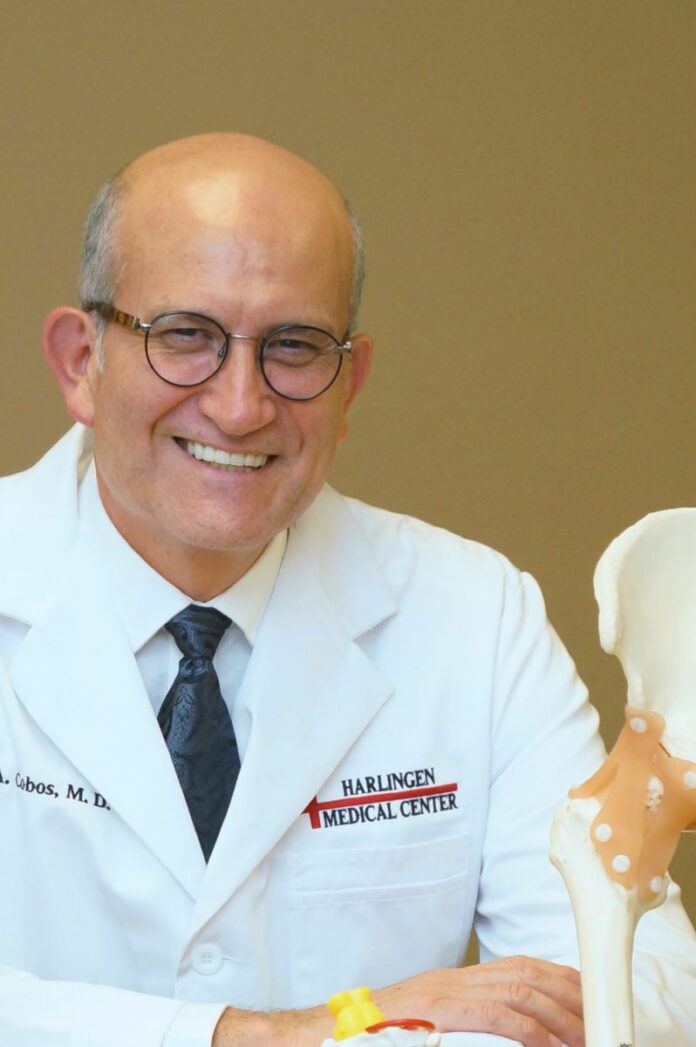HARLINGEN – If you, or someone you know, experience pain when you walk, cannot bend your knee or hip, experience knee or hip pain while you rest, you are not alone.
More than one million Americans are expected to undergo a joint replacement in 2016. Thanks to newer techniques, joint replacement is now less painful and requires less time for recovery; relieving pain and restoring activity to your life.
Harlingen Medical Center’s top Orthopedic Surgeon, Dr. Jose Cobos, will discuss the topic when he presents the first HMC Doc Talk Lecture of the New Year on Wednesday, January 13, 2016 at 6 p.m., at the hospital’s Medical Office Building (MOB) Conference Room.
The HMC Doc Talk Lecture, titled “Total Knee & Hip Replacement: Less Pain, Easier Recovery,“ will feature an in depth PowerPoint on the topic and will be followed by a question-and-answer session.
In his lecture, Dr. Cobos will cover the following topics:
– What is total knee replacement / What is hip replacement
– Newer treatments for pain management
– Who should consider knee / hip replacement
– Newer surgical techniques to address joint replacement, and
– Ensure less pain
– Ensure less blood loss during surgery
– Ensure expedited release from hospital
– Ensure expedited recovery with less stressful physical therapy
– Latest surgical techniques that are
– Less invasive
– Easier to recover from
– Benefits of joint replacement
“Patients who have severe pain, due to the destruction of the knee or hip joint, and suffer from physical function impairment are a likely candidate for joint replacement,“ said Dr. Cobos.
“These individuals may experience excruciating pain while attempting some form of movement. But, joint replacement surgery will relieve pain the individual may be experiencing. The surgery will allow us to remove the damaged portion of the joint and replace it with plastic and metal parts. This will restore normal physical activity to the patient.”
Total knee replacement surgery is performed to remove the end of the femur, also known as the thighbone, and replace it with a metal shell.
The end of the lower leg bone, also known as the tibia, is also removed and replaced with a channeled plastic piece with a metal stem. In some cases, a plastic button may also be added under the kneecap surface – depending on the condition of the kneecap portion of the knee joint.
The artificial components of a total knee replacement are called the prosthesis.
Hip replacement surgery is performed to remove a painful hip joint with arthritis. It is replaced with an artificial joint often made from metal and plastic components.
It usually is done when all other treatment options have failed to provide adequate pain relief for the patient.
“Before a patient undergoes joint replacement surgery, it is imperative that the joints closest to the diseased knee, or hip, are thoroughly evaluated. This must be done to ensure an optimal outcome for the patient and an effective recovery from the surgery,“ said Dr. Cobos.
The Harlingen Medical Center Doc Talk Lectures are open to the public and there is no fee to attend.
If you would like to attend this lecture, you are kindly asked to RSVP with the Business Development and Marketing Department at (956) 365-1848 or at [email protected].
The HMC Doc Talk Lecture Series is hosted by the Harlingen Medical Center Community Relations Program between the months of October and May.
The lectures are hosted to offer the public free health and wellness education, as well as an opportunity to ask questions of the lecturing physician and obtain immediate responses.





